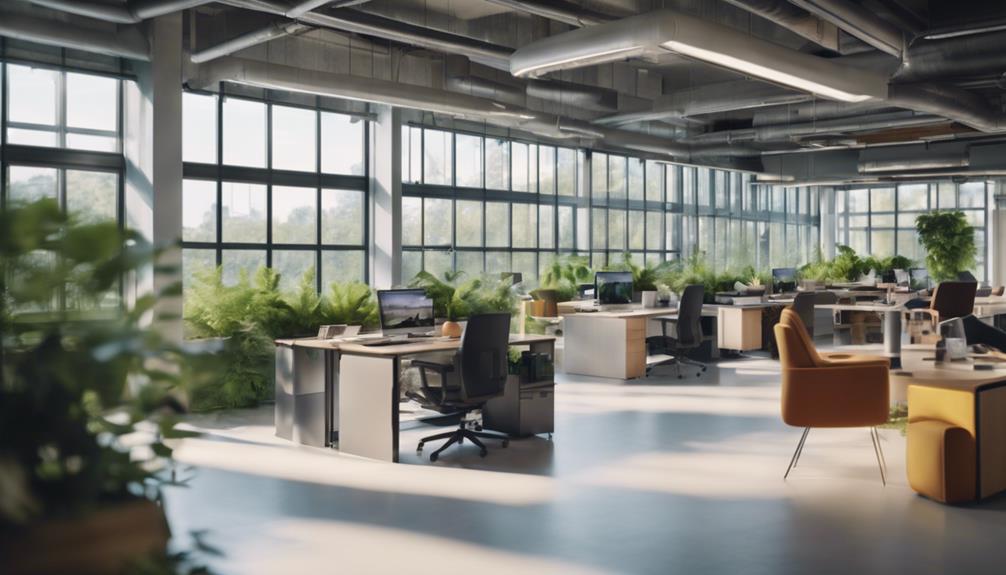In 2022, the rise of remote work transformed your perception of flexibility and productivity. A significant 24% increase in remote job adoption showed that over 75% of remote workers felt more productive. You likely noticed the demand for flexible schedules, with 66% willing to seek jobs that allow remote options. As companies prioritize health and wellness, they're investing in supportive programs to boost employee satisfaction. Inclusivity also became essential, with DEI initiatives driving retention. This evolving landscape emphasizes the importance of feedback. Keep exploring the trends that are shaping the future of work and how they could impact your experience.
Key Takeaways
- Remote work adoption surged by 24% in 2022, with over 75% of remote workers reporting increased productivity.
- The demand for flexible schedules grew, with 20% of workers prioritizing flexibility as a key improvement.
- Modern workplace designs now emphasize comfort and functionality, blending home-like environments with collaborative spaces.
- Health and wellness initiatives became crucial, as companies invested in programs to combat burnout and enhance job satisfaction.
Rise of Remote Work
Remote work has rapidly become a common choice for many employees, with a significant 24% increase in adoption from 2021 to 2022.
You might find that working from home offers fewer interruptions and a more comfortable environment, contributing to increased productivity. In fact, over 75% of remote workers report feeling more productive in their roles.
However, navigating remote work can also present challenges. Maintaining company culture and building relationships with colleagues can be tough when you're not in the office. Additionally, many employees experience increased stress due to ever-changing remote policies.
As you adapt to this new landscape, it's essential to find a balance that maximizes your productivity while staying connected with your team and fostering a positive work environment.
The Demand for Flexibility
As workers embrace the benefits of remote work, the demand for flexibility in schedules and locations has surged, reflecting a desire for greater autonomy in their professional lives.
You likely value the ability to set your own hours, which enhances your work-life balance and boosts productivity. Many of your peers agree—20% consider flexible schedules the most important workplace improvement.
Employers must recognize this shift, as 66% of workers would pursue flexible jobs if remote options disappear.
Clear communication and consistent policies are essential to address concerns about productivity. By listening to employee feedback, organizations can create a supportive environment that fosters satisfaction and engagement, ultimately leading to a more motivated workforce that thrives in a flexible landscape.
Evolving Workplace Design

Workplace design is rapidly evolving to meet the diverse needs of employees, blending comfort and functionality to enhance collaboration and productivity. You'll find that modern offices now emphasize spaces that cater to focused work, meetings, and creative brainstorming sessions. Additionally, wellness-focused amenities such as ergonomic furniture and quiet zones are becoming essential features, ensuring employees can maintain both physical and mental well-being. Technologies that support remote and hybrid work models have also become integral, reflecting the broader shifts in marcus tate workplace evolution. These innovations not only prioritize employee satisfaction but also align with the changing dynamics of how and where work gets done.
| Design Element | Purpose |
|---|---|
| Resimercial Spaces | Combine home comforts with work |
| Collaborative Areas | Foster teamwork and innovation |
| Private Zones | Allow for concentration and focus |
| Flexible Furniture | Adapt to various work styles |
These changes create inviting environments, making work feel less like a chore and more like a productive experience. As offices adapt, you'll notice a significant boost in engagement and overall satisfaction among your colleagues.
Focus on Health and Wellness
The shift towards more inviting and functional office designs also highlights an increasing focus on health and wellness, recognizing the importance of mental and physical well-being in today's work environment.
Companies are investing in wellness programs, like meditation and fitness classes, to combat rising burnout rates, particularly among Millennials and Gen Z.
You might notice remote work models now integrating telehealth options and virtual social gatherings, promoting a sense of community.
By prioritizing health initiatives, employers not only enhance job satisfaction but also boost productivity.
When you feel supported in your well-being, you're more engaged and committed to your work.
This approach fosters a healthier workplace culture, essential for retaining top talent in today's competitive landscape.
Advancements in DEI Initiatives

Advancements in DEI initiatives reflect a growing commitment to creating fairer and more inclusive environments where every employee feels valued and supported. Organizations are increasingly recognizing the importance of mental health awareness and accommodations for disabilities.
By investing in wellness programs, such as meditation and fitness, companies are fostering a culture that prioritizes employee well-being. You'll find that a lack of DEI commitment can lead to high turnover rates, while inclusive practices enhance retention and satisfaction.
Employers are actively seeking to address systemic biases and provide equitable opportunities for all staff. As you engage in these initiatives, remember that your involvement is crucial for driving meaningful change within your organization and ensuring everyone has a voice.
Future Strategies for Organizations
Organizations must prioritize employee-first policies and flexible workspaces to thrive in the evolving landscape of work. You should focus on creating environments that foster collaboration while allowing for individual autonomy. Embracing resimercial design can bridge the gap between home comfort and workplace functionality.
Here's a quick overview of future strategies:
| Strategy | Benefits | Implementation Tips |
|---|---|---|
| Employee-First Policies | Boosts morale and retention | Regularly assess employee needs |
| Flexible Workspaces | Enhances productivity and satisfaction | Invest in adaptable office designs |
| DEI Initiatives | Promotes inclusivity and engagement | Integrate DEI goals in hiring and culture |
Importance of Employee Feedback

Employee feedback is crucial for shaping work policies that truly resonate with your team's needs and preferences.
By actively seeking input, you create an environment where everyone feels valued and heard. This practice not only boosts morale but also enhances productivity and retention.
Here are some key benefits of prioritizing employee feedback:
- Encourages open communication and transparency
- Identifies areas for improvement in workplace culture
- Fosters a sense of ownership and responsibility among employees
- Drives innovation by incorporating diverse perspectives
Incorporating feedback into your decision-making process allows you to tailor work policies that align with your team's unique dynamics, ultimately leading to a more engaged and motivated workforce.
Conclusion
As you adapt to the evolving workplace, remember that 58% of workers prefer remote or hybrid options, highlighting the need for flexibility.
Embracing these changes not only enhances your job satisfaction but also supports your well-being.
Organizations that prioritize inclusive designs and DEI initiatives foster collaboration and productivity, ensuring everyone feels valued.
By staying attuned to these trends and actively seeking feedback, you can thrive in this new era of work and shape a more fulfilling career.










